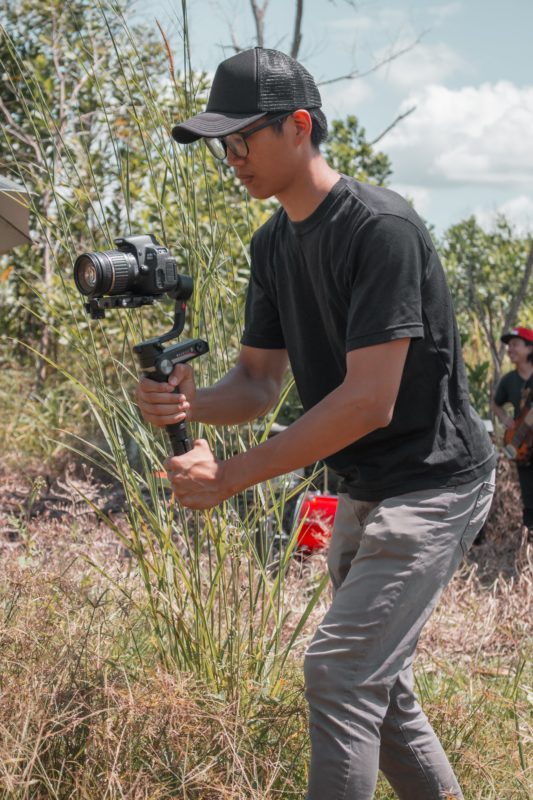
All of us progressive, mindful, climate-change advocates in Film/TV careers know that our industry is one the most energy intensive in the world. But you might not know exactly how much energy we gobble up every day in the production of a single hour of TV content. According to the British Academy of Film and Television Arts (BAFTA), around 28,660 pounds of CO2 are emitted in the production of a single hour of TV content. A blockbuster film with a $70m budget produces 2,840 tons of CO2 and it’s the equivalent of 11 times a trip from the moon to the earth. (it takes 3,700 acres of forest to absorb the equivalent in a year). Often filmed across several countries, 51% of these vast CO2 emissions are transport-related.
Think about that for a second.
If your one second is up and you have finished picking yourself up off the floor, be thankful that there are activists among of us who figured this out a few years ago and there are some great strides taking place in the international filmmaking world. Of course, much more needs to be done, but this is a start of consciousness-raising and resources for some of the amazing and impactful sustainability initiatives and organizations happening right now.
By following sustainable practices, filmmakers can reduce their environmental impact, save money, and create a better world for future generations. One of the most significant ways to make film production more sustainable is to reduce energy consumption.
It’s happening, baby!
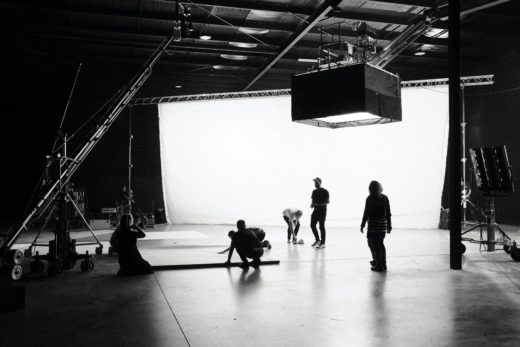
Accelerated by the pandemic, virtual production technologies are reducing and sometimes eliminating travel associated with film and TV productions. Virtual production studios and sound stages, powered by virtual reality (VR) and augmented reality (AR), use LED walls and green screens to transform many locations into a given set, which replaces sets and physical props of all shapes and sizes to help reduce material waste. I recently directed on a Volume Wall and any concerns I had about jobs being replaced evaporated when I saw that all departments were fully engaged and we even had the addition of the Pixomondo ‘Brain Bar’ – approximately 12 computer programmers hard at work on a daily basis.
The Netflix smash hit Bridgerton was able to reduce emissions on Season 2 in part by piloting a GeoPura emission-free, green hydrogen power unit in place of multiple diesel generators. Power from the unit was enough to replace several diesel generators, while by-products included clean drinking water and silence. Silence on a film set? Whodathunk it?
All this is great news for eagle-eyed Production Managers, always anxious to save money and deliver on budget.
The blockbuster ‘The Amazing Spider-Man 2’ reportedly saved $400,000 by implenting a recycling program started by the wardrobe department who sourced textiles from farmers’ markets every week and over 49 tons of materials were recovered from its sets for donation or reuse on future films. All that left over food we always have? 5,862 meals were donated to local shelters. From biodegradable snow and water-based smoke to eliminating plastic water bottles and using eco-friendly detergents on set, the filmmakers achieved a 52% waste diversion rate from landfills to become the most eco-friendly and financially successful film in the history of Sony Pictures. Kudos!!
In Canada, the CBC has hired a sustainability coordinator to oversee sustainable practices in filmmaking. Using the Albert Calculator (more info below) on all CBC shows is now a requirement.
The national funding source, Telefilm Canada, has updated its production budget model through the lense of sustainability and EDI (equity, diversion and inclusion). The updated budget model stems from consultations with various industry stakeholders, which have resulted in changes to the names of budget item categories, the addition of jobs, and the insertion of lines that serve as reminders for more sustainable and inclusive film shoots.
And there’s more…
Makeovers, property and consumer programming provide a good platform for spreading the word. The BBC’s Shop Well for the Planet ; Channel 4’s Grand Designs, abd Fremantle’s Naked have been praised for highlighting the use of recycled materials. Eco-friendly behaviour is increasingly being knitted into popular programming. Even Jeremy Clarkson’s softening views about climate change have been shown during Amazon hit Clarkson’s Farm, from Expectation. As The Handmaid’s Tale screenwriter Dorothy Fortenberry has said, “If you’re making a story about anything, in any place, and you don’t have climate change in it, that’s a science-fiction story.”
Drama production has some of the biggest production challenges around emissions. At Carnival Films, head of production Charlotte Ashby has been a leading force behind the development of a Green is Universal production toolkit, which is used across the Universal International Studios group. The toolkit, which includes guidelines, start-up slides and templates, is aligned with the Albert Calculator and shared with the industry through Creative England. The approach helped the team to achieve Albert certification for both season 5 of The Last Kingdom and the new BBC drama Dodger.
What can I do?
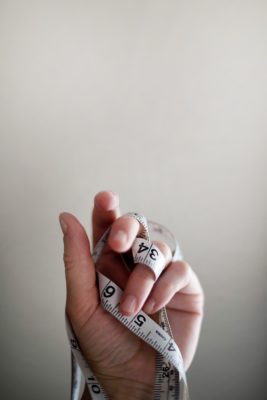
Measure Twice, Cut Once
This old saying definitely applies to achieving sustainability in our industry. If you don’t understand exactly how much energy you’re consuming in the multiple layers and departments in the filmmaking process, how the heck can you figure out what to do about it? From research through pre-production, production, and post, it’s necessary to figure out a way to measure the carbon footprint of any production in order to come up with a plan to lower impact and increase sustainability.
There are several measuring systems out there now but Albert’s Carbon Calculator, originally developed by the BBC in 2011, has been critical for the TV industry. The next step is for all productions to be Albert-certified. “We’re there to hold the industry to account on science-based targets,” says Katy Tallon, Albert industry sustainability manager, “the certification is a good thing to strive for on the route to net zero.” In 2020, while certified production numbers were up to nearly 500, this was just one-quarter of the number of shows using the calculator.
For more information on Albert:
https://wearealbert.org/production-handbook/production-tools/
In Canada, the National Climate Action Sustainability Committee (NCASC) created a website called DGC Green. DGC Green has produced one of the first Emissions and Generator Usage Calculators to reduce the use of diesel and encourage alternative choices of green energy. The Calculator calculates Fuel Used, Fuel Costs and Emissions.
More information:
In Europe, the Green Film pre-assessment tool provides a simulation of the score an audiovisual project can achieve on the Green Film checklist and allows a production to predict the economic and environmental costs or benefits.
Energy Use Begone!
One of the best ways we can make film production more sustainable is to reduce energy consumption. Start by significantly reducing energy use lighting to energy-efficient equipment and practices. Using LED lights, for example, can reduce energy use by up to 90% compared to traditional incandescent lighting. You can also make use of natural lighting as much as possible, reducing the need for artificial lighting. For example, shooting scenes during the day or in locations with large windows can reduce the need for artificial lighting. Where appropriate, make the most of our natural assets.
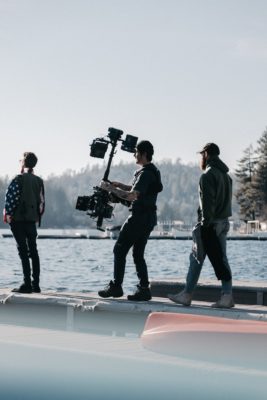
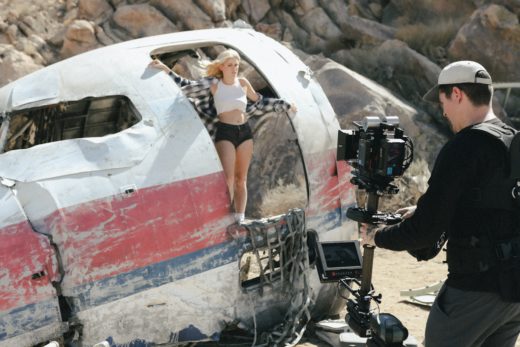
Here’s a video on sustainable practices by Production Manager Mary Anne Waterhouse with the Director’s Guild of Ontario’s Sustainability Committee:
Make Great Choices
The call has gone out and the materials industry is responding to the need to use sustainable materials for set design, costumes, and props. Plastic and synthetic fabrics are not biodegradable and can have a significant impact on the environment. So, if props are needed, try using sustainable materials, such as bamboo, recycled materials, or natural fabrics like cotton or wool.

Looking for ECO FRIENDLY WALLPAPER? At Spoonflower Inc., all of their wallpapers are made with water-based pigment inks and dyes. Spoonflower offers three different types of eco-friendly wallpaper. Both the pre-pasted and peel and stick options are formaldehyde-, phthalate- and PVC-free and do not contain flame retardants. https://www.spoonflower.com/
Here’s a great list of vendors in Canada and the U.S. who provide alternative sustainable services to the TV/Film industry:
https://dgcgreen.ca/resources/green-vendors-suppliers/
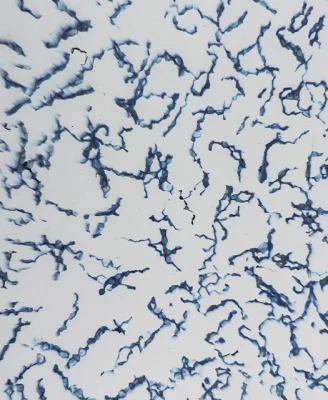
In the U.S., The Good Plastic Company is just one example of a company providing products that are good candidates to replace Sintra, which are used prolifically for sign manufacturing.
The Art Directors Guild in the US also has a list of sustainable vendors, which you can obtain by reaching out to them: https://adg.org/
Reduce, reduce, reduce!
Think about all the waste film production generates: plastic water bottles, food packaging, and materials used for set construction, to name a few. Imagine what would happen if you stop using disposable items like plastic cups and plates and instead use glass and ceramicware or biodegradable or compostable alternatives from companies like Reusables.com. The results are huge.
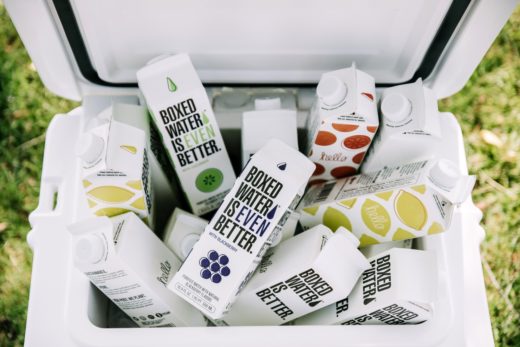
Film sets go through a ridiculously high amount of water for personal consumption. Though you can’t ask people not to drink water while filming, providing them with reusable or recyclable water bottles can make a significant impact.

A new company that is providing a unique recycle/reuse service in the industry is Urbanjacks. Not only do they remove wood products from movie sets (so it doesn’t get burned, buried, or fill up landfills), they then treat and repurpose the wood into stronger, straighter, more sustainable lumber than virgin that can be used over and over again on your next project.
Their wood is perfect for a wide range of non-structural projects, from crafting exquisite sets and cabinets to designing intricate wall paneling, DIY crafts, and so on. The possibilities are endless and remember, practical sets and props are still part of the Volume Wall experience.
For more information: www.theurbanjacks.com
Construction waste is a huge generator of the carbon footprint produced by Art Department and Construction crews. Ontario Green Screen has developed a list of resources for material sharing on the website
https://digitallibrary.ontariocreates.ca/DigitalLibrary/OGS/LinksandResources.aspx
Habitat for Humanity is happy to offload your construction materials https://www.habitat.org/ and several brands of recycled paint are now available at Home Depot and other suppliers.
Brilliant: DGC Ontario Sustainability Committee is working on providing material exchange for film students who require materials for making their films.
https://thewiderlens.ca/series/members-making-waves/members-making-waves-stacy-morris/
Location, Location, Location!
Where you shoot can impact sustainability in several ways. For example, shooting on location in a city can mean less need for transportation, reducing emissions from vehicles. Conversely, shooting in a remote location could have a significant carbon footprint due to the need to transport crew, equipment, and supplies. We also suggest where possible limiting the number of locations, so that there is less of a need for transport. Shooting in a controlled environment like a sound stage studio can also increase sustainability. Do some cost comparisons between location and studio shooting. You might be surprised, depending on the size and scope of your needs.
DGC Ontario Sustainability Committee has supported Ontario Green Screen to create a Grid tie-in Map similar to British Columbia. Knowing where Ontario locations can tie in to existing energy sources reduces the carbon footprint. The Map is currently being upgraded to provide more accurate data.
https://digitallibrary.ontariocreates.ca/DigitalLibrary/OGS/AboutUs.aspx


Fly? Train? Drive? Bicycle? Walk?
Film productions require a lot of transportation, from moving equipment to transporting actors and crew. By using sustainable transportation, like electric or hybrid vehicles, and traveling by train, we can reduce emissions and save on fuel costs. Carpooling is another way to reduce emissions and save money. In some cities pre-production teams can bicycle to work or use public transit.
Education is the Key
In order to keep making strides forward on this important issue, It’s essential to educate the cast and crew about sustainable practices and encourage them to participate in sustainability efforts.
By following sustainable practices, filmmakers, whether you are part of a social enterprise or not, can reduce your environmental impact, save money, and create a better world for future generations. Heck, I think there should be awards given for the most sustainable departments or productions (we do like our award shows ;))
There’s lots more going on out there than I could cover in this article. Here are links to more information:
https://www.linkedin.com/pulse/sustainability-film-production-inside-job-productions/
Thanks to:
Astra Burka, Andrew Gainor, and the DGC Canada/Ontario Sustainability Committee, and Dawn Snyder at the Art Director’s Guild for their invaluable help and research. Both organizations are constantly updating their lists of sustainable vendors and new ideas.
Finally, I leave you with a link to a great video about a great straw experiment that Director/Host Auri Jackson created at Buzz Feed. It’s amazing how something as small as replacing plastic straw usage with more sustainable practices can have an amazing impact:
This doesn’t have to be painful. It’s important to keep the ball moving forward so stay light, informed, and proactive so we can keep growing our industry and keep our jobs in sustainable ways forever.

Filmtools
Filmmakers go-to destination for pre-production, production & post production equipment!
Shop Now